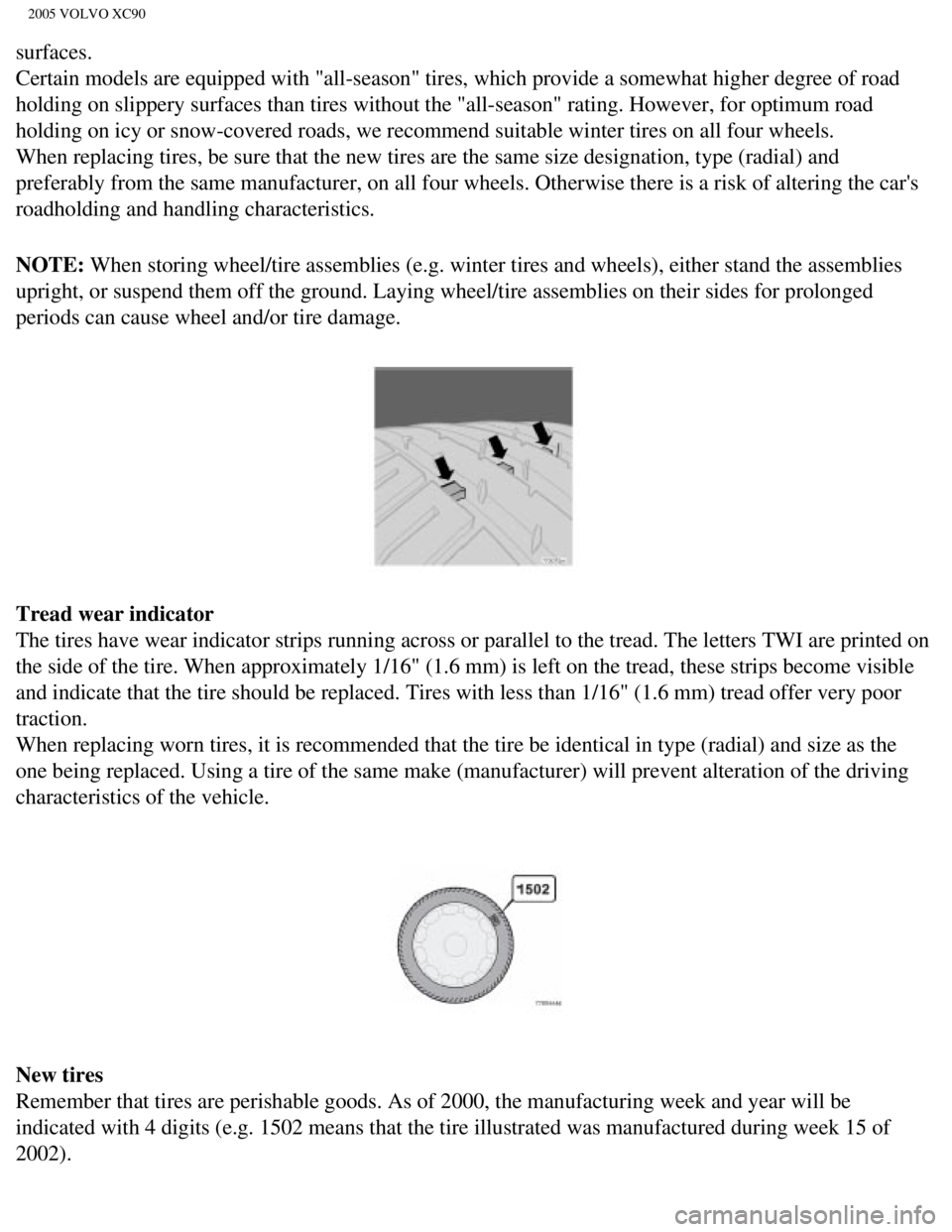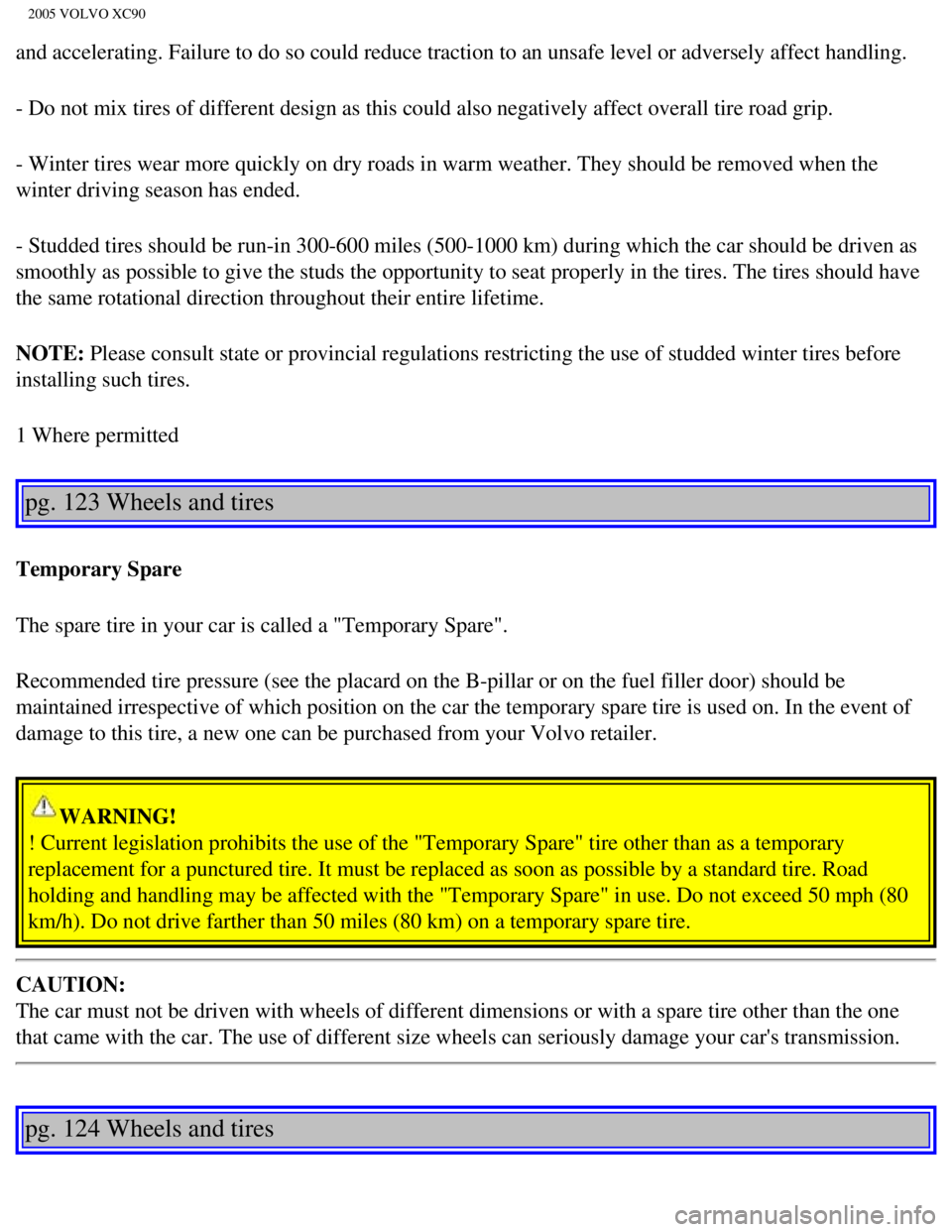2005 VOLVO XC90 winter tires
[x] Cancel search: winter tiresPage 147 of 263

2005 VOLVO XC90
are used more often. Moreover, the capacity of the battery decreases as \
the temperature drops. In very
cold weather, a poorly charged battery can freeze and be damaged. It is \
therefore advisable to check the
state of charge more frequently and spray an antirust oil on the battery\
posts.
l Volvo recommends the use of snow tires on all four wheels for winter driving - see section "Wheels
and tires."
l To prevent the washer fluid reservoir from freezing, add washer solvents containing antifreeze (see
page 140 for the location of the washer fluid reservoir).
This is important since dirt is often splashed on the windshield during \
winter driving, requiring the
frequent use of the washers and wipers. Volvo Washer Solvent should be d\
iluted as follows:
Down to 14° F (-10° C): 1 part washer solvent and 4 parts water \
Down to 5° F (-15° C): 1 part washer solvent and 3 parts water
Down to 0° F (-18° C): 1 part washer solvent and 2 parts water
Down to -18° F (-28° C): 1 part washer solvent and 1 part water \
l Use Volvo Teflon Lock Spray in the locks.
NOTE: Avoid the use of de-icing sprays as they can cause damage to the locks.
W Winter/Wet driving mode-enhanced vehicle traction
l Mode W will only function if the gear selector is in the (D)rive position.
l Press the button at the base of the gear selector to engage/disengage th\
is driving mode.
l An LED in the button will light up to indicate that W is engaged and thi\
s will also be displayed in the
instrument panel (see
page 26).
l This mode may be selected for starting/moving off on slippery roads.
* Synthetic oil is not used when the oil is changed at the normal mainte\
nance intervals except at owner request and at additional
charge. Please consult your Volvo retailer.
pg. 110 Starting and driving
Before a long distance trip
It is always worthwhile to have your vehicle checked at a Volvo retailer\
before driving long distances.
Your retailer will also be able to supply you with bulbs, fuses, spark p\
lugs and wiper blades for your use
in the event that problems occur.
As a minimum, the following items should be checked before any long trip\
:
l Check that engine runs smoothly and that fuel consumption is normal.
l Check for fuel, oil, and fluid leakage
l Check transmission oil level*.
l Check condition of drive belts.
l Check state of the battery's charge.
file:///K|/ownersdocs/2005/2005_XC90/05xc90_06b.htm (17 of 18)12/30/20\
06 4:42:35 PM
Page 156 of 263

2005 VOLVO XC90
surfaces.
Certain models are equipped with "all-season" tires, which provide a som\
ewhat higher degree of road
holding on slippery surfaces than tires without the "all-season" rating.\
However, for optimum road
holding on icy or snow-covered roads, we recommend suitable winter tires\
on all four wheels.
When replacing tires, be sure that the new tires are the same size desig\
nation, type (radial) and
preferably from the same manufacturer, on all four wheels. Otherwise the\
re is a risk of altering the car's
roadholding and handling characteristics.
NOTE: When storing wheel/tire assemblies (e.g. winter tires and wheels), ei\
ther stand the assemblies
upright, or suspend them off the ground. Laying wheel/tire assemblies on\
their sides for prolonged
periods can cause wheel and/or tire damage.
Tread wear indicator
The tires have wear indicator strips running across or parallel to the t\
read. The letters TWI are printed on
the side of the tire. When approximately 1/16" (1.6 mm) is left on the\
tread, these strips become visible
and indicate that the tire should be replaced. Tires with less than 1/16\
" (1.6 mm) tread offer very poor
traction.
When replacing worn tires, it is recommended that the tire be identical \
in type (radial) and size as the
one being replaced. Using a tire of the same make (manufacturer) will \
prevent alteration of the driving
characteristics of the vehicle.
New tires
Remember that tires are perishable goods. As of 2000, the manufacturing \
week and year will be
indicated with 4 digits (e.g. 1502 means that the tire illustrated was \
manufactured during week 15 of
2002).
file:///K|/ownersdocs/2005/2005_XC90/05xc90_08.htm (2 of 17)12/30/2006\
4:42:37 PM
Page 161 of 263

2005 VOLVO XC90
Erasing warning messages
When a low tire pressure warning message has been displayed, and the tir\
e pressure warning light has
come on:
1. Use a tire pressure gauge to check the inflation pressure of all four\
tires.
2. Re-inflate the tire(s) to the correct pressure (consult the tire p\
ressure placard or the table on
page 115).
3. Drive the car for at least one minute at a speed of 20 mph (30 km/h)\
or faster. This will erase the
warning text and the warning light will go out.
WARNING!
Incorrect inflation pressure could lead to tire failure, resulting in a \
loss of control of the
vehicle.
Changing tires
Please note the following when changing or replacing the factory install\
ed TPMS wheels/tires on the
vehicle:
Only the factory-mounted wheels are equipped with TPMS sensors in the va\
lves.
If the vehicle is equipped with a temporary spare tire, this tire does n\
ot have a TPMS sensor.
If, for example, winter wheels/tires are used that are not equipped with\
TPMS sensors, the message
TIRE PRESSURE SYSTEM SERVICE REQUIRED will be displayed after the car ha\
s been driven for
several minutes at approximately 35 mph (50 km/h) or faster.
This message will remain on until wheels with TPMS sensors are mounted o\
n the vehicle and it has been
driven for at least one minute at a speed of 20 mph (30 km/h) or faste\
r.
pg. 117 Wheels and tires
TPMS valves can be fitted on winter wheels or full-size spare wheels/tir\
es. Consult your Volvo retailer.
CAUTION:
When inflating tires with TPMS valves, press the pump's mouthpiece strai\
ght onto the valve to help
avoid bending or otherwise damaging the valve.
file:///K|/ownersdocs/2005/2005_XC90/05xc90_08.htm (7 of 17)12/30/2006\
4:42:37 PM
Page 167 of 263

2005 VOLVO XC90
WARNING!
The temperature grade for this tire is established for a tire that is pr\
operly inflated and not overloaded.
Excessive speed, under-inflation, or excessive loading, either separatel\
y or in combination, can cause
heat buildup and possible tire failure.
pg. 122 Wheels and tires
Snow chains, snow tire, studded tires
Snow chains
Snow chains can be used on your Volvo with the following restrictions:
l Snow chains should be installed on front wheels only. Use only Volvo app\
roved snow chains.
l If accessory, aftermarket or "custom" tires and wheels are installed and\
are of a size different than the
original tires and wheels, chains in some cases CANNOT be used. Sufficie\
nt clearances between chains
and brakes, suspension and body components must be maintained.
l Some strap-on type chains will interfere with brake components and there\
fore CANNOT be used.
l All Wheel Drive models: Snow chains should only be installed on the fron\
t wheels. Only chains
adapted for AWD models should be used.
NOTE: Consult your Volvo retailer for additional snow chain information.
CAUTION
- Check local regulations regarding the use of snow chains before instal\
ling.
- Always follow the chain manufacturer's installation instructions caref\
ully. Install chains as tightly as
possible and retighten periodically.
- Never exceed the chain manufacturer's specified maximum speed limit. (\
Under no circumstances
should you exceed 31 mph 50 km/h)
- Avoid bumps, holes or sharp turns when driving with snow chains.
- The handling of the vehicle can be adversely affected when driving wit\
h chains. Avoid fast or sharp
turns as well as locked wheel braking.
Snow tires, studded tires
1
Tires for winter use:
- Owners who live in or regularly commute through areas with sustained p\
eriods of snow or icy driving
conditions are strongly advised to fit suitable winter tires to help ret\
ain the highest degree of traction.
- It is important to install winter tires on all four wheels to help ret\
ain traction during cornering, braking,
file:///K|/ownersdocs/2005/2005_XC90/05xc90_08.htm (13 of 17)12/30/200\
6 4:42:37 PM
Page 168 of 263

2005 VOLVO XC90
and accelerating. Failure to do so could reduce traction to an unsafe le\
vel or adversely affect handling.
- Do not mix tires of different design as this could also negatively aff\
ect overall tire road grip.
- Winter tires wear more quickly on dry roads in warm weather. They shou\
ld be removed when the
winter driving season has ended.
- Studded tires should be run-in 300-600 miles (500-1000 km) during wh\
ich the car should be driven as
smoothly as possible to give the studs the opportunity to seat properly \
in the tires. The tires should have
the same rotational direction throughout their entire lifetime.
NOTE: Please consult state or provincial regulations restricting the use of st\
udded winter tires before
installing such tires.
1 Where permitted
pg. 123 Wheels and tires
Temporary Spare
The spare tire in your car is called a "Temporary Spare".
Recommended tire pressure (see the placard on the B-pillar or on the fu\
el filler door) should be
maintained irrespective of which position on the car the temporary spare\
tire is used on. In the event of
damage to this tire, a new one can be purchased from your Volvo retailer\
.
WARNING!
! Current legislation prohibits the use of the "Temporary Spare" tire ot\
her than as a temporary
replacement for a punctured tire. It must be replaced as soon as possibl\
e by a standard tire. Road
holding and handling may be affected with the "Temporary Spare" in use. \
Do not exceed 50 mph (80
km/h). Do not drive farther than 50 miles (80 km) on a temporary spar\
e tire.
CAUTION:
The car must not be driven with wheels of different dimensions or with a\
spare tire other than the one
that came with the car. The use of different size wheels can seriously d\
amage your car's transmission.
pg. 124 Wheels and tires
file:///K|/ownersdocs/2005/2005_XC90/05xc90_08.htm (14 of 17)12/30/200\
6 4:42:37 PM